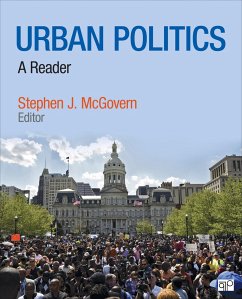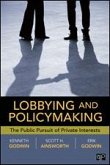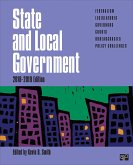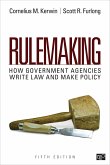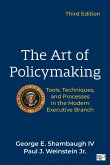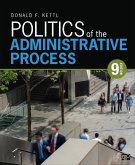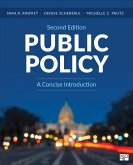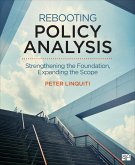Urban Politics
A Reader
Herausgeber: Mcgovern
Urban Politics
A Reader
Herausgeber: Mcgovern
- Broschiertes Buch
- Merkliste
- Auf die Merkliste
- Bewerten Bewerten
- Teilen
- Produkt teilen
- Produkterinnerung
- Produkterinnerung
This book examines the evolving structure of political power in American cities revealing how changes in society relate to the global and national economy, immigration and internal migration, racial and ethnic transition, and how technological advances affect city politics.
Andere Kunden interessierten sich auch für
![Lobbying and Policymaking Lobbying and Policymaking]() Ken GodwinLobbying and Policymaking83,99 €
Ken GodwinLobbying and Policymaking83,99 €![State and Local Government State and Local Government]() State and Local Government84,99 €
State and Local Government84,99 €![Rulemaking Rulemaking]() Cornelius Martin KerwinRulemaking104,99 €
Cornelius Martin KerwinRulemaking104,99 €![The Art of Policymaking The Art of Policymaking]() George ShambaughThe Art of Policymaking80,99 €
George ShambaughThe Art of Policymaking80,99 €![Politics of the Administrative Process Politics of the Administrative Process]() Donald F. Kettl (University of Texas, Austin, TX, USA)Politics of the Administrative Process216,99 €
Donald F. Kettl (University of Texas, Austin, TX, USA)Politics of the Administrative Process216,99 €![Public Policy Public Policy]() Sara R. R. Rinfret (Northern Arizona University, Flagstaff, USA)Public Policy183,99 €
Sara R. R. Rinfret (Northern Arizona University, Flagstaff, USA)Public Policy183,99 €![Rebooting Policy Analysis Rebooting Policy Analysis]() Peter D. LinquitiRebooting Policy Analysis183,99 €
Peter D. LinquitiRebooting Policy Analysis183,99 €-
-
-
This book examines the evolving structure of political power in American cities revealing how changes in society relate to the global and national economy, immigration and internal migration, racial and ethnic transition, and how technological advances affect city politics.
Hinweis: Dieser Artikel kann nur an eine deutsche Lieferadresse ausgeliefert werden.
Hinweis: Dieser Artikel kann nur an eine deutsche Lieferadresse ausgeliefert werden.
Produktdetails
- Produktdetails
- Verlag: SAGE Publications Inc
- UK edition
- Seitenzahl: 568
- Erscheinungstermin: 9. Februar 2016
- Englisch
- Abmessung: 229mm x 188mm x 20mm
- Gewicht: 842g
- ISBN-13: 9781506311197
- ISBN-10: 1506311199
- Artikelnr.: 48535023
- Herstellerkennzeichnung
- Libri GmbH
- Europaallee 1
- 36244 Bad Hersfeld
- gpsr@libri.de
- Verlag: SAGE Publications Inc
- UK edition
- Seitenzahl: 568
- Erscheinungstermin: 9. Februar 2016
- Englisch
- Abmessung: 229mm x 188mm x 20mm
- Gewicht: 842g
- ISBN-13: 9781506311197
- ISBN-10: 1506311199
- Artikelnr.: 48535023
- Herstellerkennzeichnung
- Libri GmbH
- Europaallee 1
- 36244 Bad Hersfeld
- gpsr@libri.de
Chapter 1: Cities in a Global Era
Introduction
1-1 Richard C. Longworth, "Urban America: U.S. Cities in the Global Era"
1-2 Alan Ehrenhalt, "The Great Inversion"
1-3 Alan Mallach, "The Uncoupling of the Economic City: Increasing Spatial
and Economic Polarization in American Older Cities"
Conclusion
Part I: THE FORMATION OF URBAN POLITICS
Chapter 2: Politics in the Preindustrial City
Introduction
2-1 Alan Tully, "The Ruling Elite"
2-2 Sam Bass Warner Jr., "The Environment of Private Opportunity"
2-3 Daniel J. Boorstin, "The Businessman as City Booster"
Conclusion
Chapter 3: Machine Politics
Introduction
3-1 William L. Riorden, "To Hold Your District: Study Human Nature and Act
Accordin'"
3-2 Robert Merton, "The Latent Functions of the Machine"
3-3 Alexander Callow, "That Impudent Autocrat"
Public Policy Applications: The Administration of City Government
Conclusion
Chapter 4: Reform Politics
Introduction
4-1 Andrew D. White, "The Government of American Cities"
4-2 Jacob A. Riis, "Genesis of the Tenement"
4-3 Stanley Schultz, "The Engineered Metropolis"
4-4 Samuel P. Hays, "The Politics of Reform in Municipal Government in the
Progressive Era"
Conclusion
PART II: URBAN POLITICS UNDER STRESS
Chapter 5: Suburbanization and the Hollowing of the City
Introduction
5-1 Kenneth T. Jackson, "The Loss of Community in Metropolitan America"
5-2 Peter Dreier, John H. Mollenkopf, and Todd Swanstrom, "The Roads Not
Taken: How Federal Policies Promote Economic Segregation and Suburban
Sprawl"
5-3 Michael N. Danielson, "Suburban Autonomy"
5-4 Arnold R. Hirsch, "The Second Ghetto and the Dynamics of Neighborhood
Change"
Conclusion
Chapter 6: Deindustrialization and the Rise of the Postindustrial City
Introduction
6-1 Thomas Sugrue, "'The Damning Mark of False Prosperities': The
Deindustrialization of Detroit"
6-2 Jon C. Teaford, "The Problem Perceived"
6-3 Joel Rast, "Creating a Unified Business Elite: The Origins of the
Chicago Central Area Committee"
6-4 Guian A. McKee, "Liberals, Race, and Jobs in Postwar Philadelphia"
Conclusion
Chapter 7: Race, Protest, and Backlash
Introduction
7-1 Stokely Carmichael and Charles V. Hamilton, "Black Power: Its Needs and
Substance"
7-2 Bayard Rustin, "From Protest to Politics: The Future of the Civil
Rights Movement"
7-3 Jonathan Rieder, "The Fenced Land" and "The Lost People"
Conclusion
Chapter 8: Crisis
Introduction
8-1 Paul S. O'Hara, "'The Very Model of Urban Decay': Outsiders' Narratives
of Industry and Urban Decline in Gary, Indiana"
8-2 Jonathan Kozol, "Children of the Invincible City: Camden, New Jersey"
8-3 Paul Peterson, "The Interests of the Limited City"
8-4 Carl Abbott, "Urbanizing the South"
Conclusion
PART III: THE POLITICS OF URBAN REVITALIZATION
Chapter 9: Cities in a Federal System
Introduction
9-1 Tracy Neumann, "Privatization, Devolution, and Jimmy Carter's National
Urban Policy"
9-2 Peter Eisinger, "City Politics in the Era of Federal Devolution"
9-3 Karen M. Paget, "Can Cities Escape Political Isolation?"
9-4 Carl Abbott, "The Portland Region: Where City and Suburbs Talk to Each
Other-and Often Agree"
Conclusion
Chapter 10: Grassroots Activism
Introduction
10-1 Saul D. Alinsky, Excerpts from Reveille for Radicals
10-2 Mark R. Warren, "A Theology of Organizing: From Alinsky to the Modern
IAF"
10-3 Michael B. Katz, "Why Don't American Cities Burn Very Often?"
Conclusion
Chapter 11: Regime Politics
Introduction
11-1 Clarence N. Stone, "Urban Regimes: A Research Perspective" and
"Conclusion"
11-2 Raphael J. Sonenshein, "Conclusions and Implications: Toward a New
Contract for Biracial Politics"
11-3 Jason Hackworth, "The Public-Private Partnership"
11-4 Paul Kantor and H. V. Savitch, "Can Politicians Bargain with Business?
A Theoretical and Comparative Perspective on Urban Development"
Conclusion
PART IV: CHANGING DYNAMICS OF URBAN POLITICS
Chapter 12: Race and Ethnicity in Contemporary Urban Politics
Introduction
12-1 Andra Gillespie, "Meet the New Class: Theorizing Young Black
Leadership in a 'Postracial' Era"
12-2 Adolph Reed Jr., "Demobilization in the New Black Political Regime:
Ideological Capitulation and Radical Failure in the Post-Segregation Era"
12-3 Arnold R. Hirsch and A. Lee Levert, "The Katrina Conspiracies: The
Problem of Trust in Rebuilding an American City"
Conclusion
Chapter 13: Immigration and Contemporary Urban Politics
Introduction
13-1 Audrey Singer, "Contemporary Immigrant Gateways in Historical
Perspective"
13-2 Domenic Vitiello, "The Politics of Immigration and Suburban
Revitalization: Divergent Responses in Adjacent Pennsylvania Towns"
13-3 Zoltan Hajnal and Jessica Trounstine, "What Underlies Urban Politics?
Race, Class, Ideology, Partisanship, and the Urban Vote"
Conclusion
Part V: VISIONS OF URBAN POLITICS TODAY
Chapter 14: Contemporary Approaches to Urban Governance
Introduction
14-1 Larry Bennett, "The Mayor among His Peers: Interpreting Richard M.
Daley"
14-2 Stephen Goldsmith, "The Story of America's Cities" and "Making a
Market"
14-3 Julian Brash, "Running Government like a Business"
14-4 Thad Williamson, "Justice, the Public Sector, and Cities:
Relegitimating the Activist State"
Conclusion
Introduction
1-1 Richard C. Longworth, "Urban America: U.S. Cities in the Global Era"
1-2 Alan Ehrenhalt, "The Great Inversion"
1-3 Alan Mallach, "The Uncoupling of the Economic City: Increasing Spatial
and Economic Polarization in American Older Cities"
Conclusion
Part I: THE FORMATION OF URBAN POLITICS
Chapter 2: Politics in the Preindustrial City
Introduction
2-1 Alan Tully, "The Ruling Elite"
2-2 Sam Bass Warner Jr., "The Environment of Private Opportunity"
2-3 Daniel J. Boorstin, "The Businessman as City Booster"
Conclusion
Chapter 3: Machine Politics
Introduction
3-1 William L. Riorden, "To Hold Your District: Study Human Nature and Act
Accordin'"
3-2 Robert Merton, "The Latent Functions of the Machine"
3-3 Alexander Callow, "That Impudent Autocrat"
Public Policy Applications: The Administration of City Government
Conclusion
Chapter 4: Reform Politics
Introduction
4-1 Andrew D. White, "The Government of American Cities"
4-2 Jacob A. Riis, "Genesis of the Tenement"
4-3 Stanley Schultz, "The Engineered Metropolis"
4-4 Samuel P. Hays, "The Politics of Reform in Municipal Government in the
Progressive Era"
Conclusion
PART II: URBAN POLITICS UNDER STRESS
Chapter 5: Suburbanization and the Hollowing of the City
Introduction
5-1 Kenneth T. Jackson, "The Loss of Community in Metropolitan America"
5-2 Peter Dreier, John H. Mollenkopf, and Todd Swanstrom, "The Roads Not
Taken: How Federal Policies Promote Economic Segregation and Suburban
Sprawl"
5-3 Michael N. Danielson, "Suburban Autonomy"
5-4 Arnold R. Hirsch, "The Second Ghetto and the Dynamics of Neighborhood
Change"
Conclusion
Chapter 6: Deindustrialization and the Rise of the Postindustrial City
Introduction
6-1 Thomas Sugrue, "'The Damning Mark of False Prosperities': The
Deindustrialization of Detroit"
6-2 Jon C. Teaford, "The Problem Perceived"
6-3 Joel Rast, "Creating a Unified Business Elite: The Origins of the
Chicago Central Area Committee"
6-4 Guian A. McKee, "Liberals, Race, and Jobs in Postwar Philadelphia"
Conclusion
Chapter 7: Race, Protest, and Backlash
Introduction
7-1 Stokely Carmichael and Charles V. Hamilton, "Black Power: Its Needs and
Substance"
7-2 Bayard Rustin, "From Protest to Politics: The Future of the Civil
Rights Movement"
7-3 Jonathan Rieder, "The Fenced Land" and "The Lost People"
Conclusion
Chapter 8: Crisis
Introduction
8-1 Paul S. O'Hara, "'The Very Model of Urban Decay': Outsiders' Narratives
of Industry and Urban Decline in Gary, Indiana"
8-2 Jonathan Kozol, "Children of the Invincible City: Camden, New Jersey"
8-3 Paul Peterson, "The Interests of the Limited City"
8-4 Carl Abbott, "Urbanizing the South"
Conclusion
PART III: THE POLITICS OF URBAN REVITALIZATION
Chapter 9: Cities in a Federal System
Introduction
9-1 Tracy Neumann, "Privatization, Devolution, and Jimmy Carter's National
Urban Policy"
9-2 Peter Eisinger, "City Politics in the Era of Federal Devolution"
9-3 Karen M. Paget, "Can Cities Escape Political Isolation?"
9-4 Carl Abbott, "The Portland Region: Where City and Suburbs Talk to Each
Other-and Often Agree"
Conclusion
Chapter 10: Grassroots Activism
Introduction
10-1 Saul D. Alinsky, Excerpts from Reveille for Radicals
10-2 Mark R. Warren, "A Theology of Organizing: From Alinsky to the Modern
IAF"
10-3 Michael B. Katz, "Why Don't American Cities Burn Very Often?"
Conclusion
Chapter 11: Regime Politics
Introduction
11-1 Clarence N. Stone, "Urban Regimes: A Research Perspective" and
"Conclusion"
11-2 Raphael J. Sonenshein, "Conclusions and Implications: Toward a New
Contract for Biracial Politics"
11-3 Jason Hackworth, "The Public-Private Partnership"
11-4 Paul Kantor and H. V. Savitch, "Can Politicians Bargain with Business?
A Theoretical and Comparative Perspective on Urban Development"
Conclusion
PART IV: CHANGING DYNAMICS OF URBAN POLITICS
Chapter 12: Race and Ethnicity in Contemporary Urban Politics
Introduction
12-1 Andra Gillespie, "Meet the New Class: Theorizing Young Black
Leadership in a 'Postracial' Era"
12-2 Adolph Reed Jr., "Demobilization in the New Black Political Regime:
Ideological Capitulation and Radical Failure in the Post-Segregation Era"
12-3 Arnold R. Hirsch and A. Lee Levert, "The Katrina Conspiracies: The
Problem of Trust in Rebuilding an American City"
Conclusion
Chapter 13: Immigration and Contemporary Urban Politics
Introduction
13-1 Audrey Singer, "Contemporary Immigrant Gateways in Historical
Perspective"
13-2 Domenic Vitiello, "The Politics of Immigration and Suburban
Revitalization: Divergent Responses in Adjacent Pennsylvania Towns"
13-3 Zoltan Hajnal and Jessica Trounstine, "What Underlies Urban Politics?
Race, Class, Ideology, Partisanship, and the Urban Vote"
Conclusion
Part V: VISIONS OF URBAN POLITICS TODAY
Chapter 14: Contemporary Approaches to Urban Governance
Introduction
14-1 Larry Bennett, "The Mayor among His Peers: Interpreting Richard M.
Daley"
14-2 Stephen Goldsmith, "The Story of America's Cities" and "Making a
Market"
14-3 Julian Brash, "Running Government like a Business"
14-4 Thad Williamson, "Justice, the Public Sector, and Cities:
Relegitimating the Activist State"
Conclusion
Chapter 1: Cities in a Global Era
Introduction
1-1 Richard C. Longworth, "Urban America: U.S. Cities in the Global Era"
1-2 Alan Ehrenhalt, "The Great Inversion"
1-3 Alan Mallach, "The Uncoupling of the Economic City: Increasing Spatial
and Economic Polarization in American Older Cities"
Conclusion
Part I: THE FORMATION OF URBAN POLITICS
Chapter 2: Politics in the Preindustrial City
Introduction
2-1 Alan Tully, "The Ruling Elite"
2-2 Sam Bass Warner Jr., "The Environment of Private Opportunity"
2-3 Daniel J. Boorstin, "The Businessman as City Booster"
Conclusion
Chapter 3: Machine Politics
Introduction
3-1 William L. Riorden, "To Hold Your District: Study Human Nature and Act
Accordin'"
3-2 Robert Merton, "The Latent Functions of the Machine"
3-3 Alexander Callow, "That Impudent Autocrat"
Public Policy Applications: The Administration of City Government
Conclusion
Chapter 4: Reform Politics
Introduction
4-1 Andrew D. White, "The Government of American Cities"
4-2 Jacob A. Riis, "Genesis of the Tenement"
4-3 Stanley Schultz, "The Engineered Metropolis"
4-4 Samuel P. Hays, "The Politics of Reform in Municipal Government in the
Progressive Era"
Conclusion
PART II: URBAN POLITICS UNDER STRESS
Chapter 5: Suburbanization and the Hollowing of the City
Introduction
5-1 Kenneth T. Jackson, "The Loss of Community in Metropolitan America"
5-2 Peter Dreier, John H. Mollenkopf, and Todd Swanstrom, "The Roads Not
Taken: How Federal Policies Promote Economic Segregation and Suburban
Sprawl"
5-3 Michael N. Danielson, "Suburban Autonomy"
5-4 Arnold R. Hirsch, "The Second Ghetto and the Dynamics of Neighborhood
Change"
Conclusion
Chapter 6: Deindustrialization and the Rise of the Postindustrial City
Introduction
6-1 Thomas Sugrue, "'The Damning Mark of False Prosperities': The
Deindustrialization of Detroit"
6-2 Jon C. Teaford, "The Problem Perceived"
6-3 Joel Rast, "Creating a Unified Business Elite: The Origins of the
Chicago Central Area Committee"
6-4 Guian A. McKee, "Liberals, Race, and Jobs in Postwar Philadelphia"
Conclusion
Chapter 7: Race, Protest, and Backlash
Introduction
7-1 Stokely Carmichael and Charles V. Hamilton, "Black Power: Its Needs and
Substance"
7-2 Bayard Rustin, "From Protest to Politics: The Future of the Civil
Rights Movement"
7-3 Jonathan Rieder, "The Fenced Land" and "The Lost People"
Conclusion
Chapter 8: Crisis
Introduction
8-1 Paul S. O'Hara, "'The Very Model of Urban Decay': Outsiders' Narratives
of Industry and Urban Decline in Gary, Indiana"
8-2 Jonathan Kozol, "Children of the Invincible City: Camden, New Jersey"
8-3 Paul Peterson, "The Interests of the Limited City"
8-4 Carl Abbott, "Urbanizing the South"
Conclusion
PART III: THE POLITICS OF URBAN REVITALIZATION
Chapter 9: Cities in a Federal System
Introduction
9-1 Tracy Neumann, "Privatization, Devolution, and Jimmy Carter's National
Urban Policy"
9-2 Peter Eisinger, "City Politics in the Era of Federal Devolution"
9-3 Karen M. Paget, "Can Cities Escape Political Isolation?"
9-4 Carl Abbott, "The Portland Region: Where City and Suburbs Talk to Each
Other-and Often Agree"
Conclusion
Chapter 10: Grassroots Activism
Introduction
10-1 Saul D. Alinsky, Excerpts from Reveille for Radicals
10-2 Mark R. Warren, "A Theology of Organizing: From Alinsky to the Modern
IAF"
10-3 Michael B. Katz, "Why Don't American Cities Burn Very Often?"
Conclusion
Chapter 11: Regime Politics
Introduction
11-1 Clarence N. Stone, "Urban Regimes: A Research Perspective" and
"Conclusion"
11-2 Raphael J. Sonenshein, "Conclusions and Implications: Toward a New
Contract for Biracial Politics"
11-3 Jason Hackworth, "The Public-Private Partnership"
11-4 Paul Kantor and H. V. Savitch, "Can Politicians Bargain with Business?
A Theoretical and Comparative Perspective on Urban Development"
Conclusion
PART IV: CHANGING DYNAMICS OF URBAN POLITICS
Chapter 12: Race and Ethnicity in Contemporary Urban Politics
Introduction
12-1 Andra Gillespie, "Meet the New Class: Theorizing Young Black
Leadership in a 'Postracial' Era"
12-2 Adolph Reed Jr., "Demobilization in the New Black Political Regime:
Ideological Capitulation and Radical Failure in the Post-Segregation Era"
12-3 Arnold R. Hirsch and A. Lee Levert, "The Katrina Conspiracies: The
Problem of Trust in Rebuilding an American City"
Conclusion
Chapter 13: Immigration and Contemporary Urban Politics
Introduction
13-1 Audrey Singer, "Contemporary Immigrant Gateways in Historical
Perspective"
13-2 Domenic Vitiello, "The Politics of Immigration and Suburban
Revitalization: Divergent Responses in Adjacent Pennsylvania Towns"
13-3 Zoltan Hajnal and Jessica Trounstine, "What Underlies Urban Politics?
Race, Class, Ideology, Partisanship, and the Urban Vote"
Conclusion
Part V: VISIONS OF URBAN POLITICS TODAY
Chapter 14: Contemporary Approaches to Urban Governance
Introduction
14-1 Larry Bennett, "The Mayor among His Peers: Interpreting Richard M.
Daley"
14-2 Stephen Goldsmith, "The Story of America's Cities" and "Making a
Market"
14-3 Julian Brash, "Running Government like a Business"
14-4 Thad Williamson, "Justice, the Public Sector, and Cities:
Relegitimating the Activist State"
Conclusion
Introduction
1-1 Richard C. Longworth, "Urban America: U.S. Cities in the Global Era"
1-2 Alan Ehrenhalt, "The Great Inversion"
1-3 Alan Mallach, "The Uncoupling of the Economic City: Increasing Spatial
and Economic Polarization in American Older Cities"
Conclusion
Part I: THE FORMATION OF URBAN POLITICS
Chapter 2: Politics in the Preindustrial City
Introduction
2-1 Alan Tully, "The Ruling Elite"
2-2 Sam Bass Warner Jr., "The Environment of Private Opportunity"
2-3 Daniel J. Boorstin, "The Businessman as City Booster"
Conclusion
Chapter 3: Machine Politics
Introduction
3-1 William L. Riorden, "To Hold Your District: Study Human Nature and Act
Accordin'"
3-2 Robert Merton, "The Latent Functions of the Machine"
3-3 Alexander Callow, "That Impudent Autocrat"
Public Policy Applications: The Administration of City Government
Conclusion
Chapter 4: Reform Politics
Introduction
4-1 Andrew D. White, "The Government of American Cities"
4-2 Jacob A. Riis, "Genesis of the Tenement"
4-3 Stanley Schultz, "The Engineered Metropolis"
4-4 Samuel P. Hays, "The Politics of Reform in Municipal Government in the
Progressive Era"
Conclusion
PART II: URBAN POLITICS UNDER STRESS
Chapter 5: Suburbanization and the Hollowing of the City
Introduction
5-1 Kenneth T. Jackson, "The Loss of Community in Metropolitan America"
5-2 Peter Dreier, John H. Mollenkopf, and Todd Swanstrom, "The Roads Not
Taken: How Federal Policies Promote Economic Segregation and Suburban
Sprawl"
5-3 Michael N. Danielson, "Suburban Autonomy"
5-4 Arnold R. Hirsch, "The Second Ghetto and the Dynamics of Neighborhood
Change"
Conclusion
Chapter 6: Deindustrialization and the Rise of the Postindustrial City
Introduction
6-1 Thomas Sugrue, "'The Damning Mark of False Prosperities': The
Deindustrialization of Detroit"
6-2 Jon C. Teaford, "The Problem Perceived"
6-3 Joel Rast, "Creating a Unified Business Elite: The Origins of the
Chicago Central Area Committee"
6-4 Guian A. McKee, "Liberals, Race, and Jobs in Postwar Philadelphia"
Conclusion
Chapter 7: Race, Protest, and Backlash
Introduction
7-1 Stokely Carmichael and Charles V. Hamilton, "Black Power: Its Needs and
Substance"
7-2 Bayard Rustin, "From Protest to Politics: The Future of the Civil
Rights Movement"
7-3 Jonathan Rieder, "The Fenced Land" and "The Lost People"
Conclusion
Chapter 8: Crisis
Introduction
8-1 Paul S. O'Hara, "'The Very Model of Urban Decay': Outsiders' Narratives
of Industry and Urban Decline in Gary, Indiana"
8-2 Jonathan Kozol, "Children of the Invincible City: Camden, New Jersey"
8-3 Paul Peterson, "The Interests of the Limited City"
8-4 Carl Abbott, "Urbanizing the South"
Conclusion
PART III: THE POLITICS OF URBAN REVITALIZATION
Chapter 9: Cities in a Federal System
Introduction
9-1 Tracy Neumann, "Privatization, Devolution, and Jimmy Carter's National
Urban Policy"
9-2 Peter Eisinger, "City Politics in the Era of Federal Devolution"
9-3 Karen M. Paget, "Can Cities Escape Political Isolation?"
9-4 Carl Abbott, "The Portland Region: Where City and Suburbs Talk to Each
Other-and Often Agree"
Conclusion
Chapter 10: Grassroots Activism
Introduction
10-1 Saul D. Alinsky, Excerpts from Reveille for Radicals
10-2 Mark R. Warren, "A Theology of Organizing: From Alinsky to the Modern
IAF"
10-3 Michael B. Katz, "Why Don't American Cities Burn Very Often?"
Conclusion
Chapter 11: Regime Politics
Introduction
11-1 Clarence N. Stone, "Urban Regimes: A Research Perspective" and
"Conclusion"
11-2 Raphael J. Sonenshein, "Conclusions and Implications: Toward a New
Contract for Biracial Politics"
11-3 Jason Hackworth, "The Public-Private Partnership"
11-4 Paul Kantor and H. V. Savitch, "Can Politicians Bargain with Business?
A Theoretical and Comparative Perspective on Urban Development"
Conclusion
PART IV: CHANGING DYNAMICS OF URBAN POLITICS
Chapter 12: Race and Ethnicity in Contemporary Urban Politics
Introduction
12-1 Andra Gillespie, "Meet the New Class: Theorizing Young Black
Leadership in a 'Postracial' Era"
12-2 Adolph Reed Jr., "Demobilization in the New Black Political Regime:
Ideological Capitulation and Radical Failure in the Post-Segregation Era"
12-3 Arnold R. Hirsch and A. Lee Levert, "The Katrina Conspiracies: The
Problem of Trust in Rebuilding an American City"
Conclusion
Chapter 13: Immigration and Contemporary Urban Politics
Introduction
13-1 Audrey Singer, "Contemporary Immigrant Gateways in Historical
Perspective"
13-2 Domenic Vitiello, "The Politics of Immigration and Suburban
Revitalization: Divergent Responses in Adjacent Pennsylvania Towns"
13-3 Zoltan Hajnal and Jessica Trounstine, "What Underlies Urban Politics?
Race, Class, Ideology, Partisanship, and the Urban Vote"
Conclusion
Part V: VISIONS OF URBAN POLITICS TODAY
Chapter 14: Contemporary Approaches to Urban Governance
Introduction
14-1 Larry Bennett, "The Mayor among His Peers: Interpreting Richard M.
Daley"
14-2 Stephen Goldsmith, "The Story of America's Cities" and "Making a
Market"
14-3 Julian Brash, "Running Government like a Business"
14-4 Thad Williamson, "Justice, the Public Sector, and Cities:
Relegitimating the Activist State"
Conclusion

